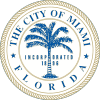Miami: Difference between revisions
No edit summary |
Population density refers to people per sq mile/km of land, not total area (especially in a city with this much water). |
||
| Line 63: | Line 63: | ||
|population_est = 413201 |
|population_est = 413201 |
||
|pop_est_as_of = 2008 |
|pop_est_as_of = 2008 |
||
|population_density_km2 = |
|population_density_km2 = 4471 |
||
|population_density_sq_mi = |
|population_density_sq_mi = 11581 |
||
|population_metro = 5414712 |
|population_metro = 5414712 |
||
|population_density_metro_km2 = |
|population_density_metro_km2 = |
||
Revision as of 08:03, 30 April 2010
Miami | |
|---|---|
City | |
| Images from top, left to right: Skyline of Downtown, American Airlines Arena, Villa Vizcaya, Bank of America Tower (Miami), Port of Miami, Freedom Tower. Images from top, left to right: Skyline of Downtown, American Airlines Arena, Villa Vizcaya, Bank of America Tower (Miami), Port of Miami, Freedom Tower. | |
| Nickname(s): The Magic City, The MIA, The 305, The Gateway to the Americas | |
 Location in Miami-Dade County and the state of Florida | |
| Country | United States |
| State | Florida |
| County | Miami-Dade |
| Settled | 1825 |
| Incorporated | July 28, 1896 |
| Named for | Mayaimi |
| Government | |
| • Type | Mayor-Commissioner Plan |
| • Mayor | Tomás Regalado (I) |
| • City Manager | Pedro G. Hernandez |
| • City Attorney | Julie O. Bru |
| • City Clerk | Priscilla Thompson |
| Area | |
| • City | 55.27 sq mi (143.1 km2) |
| • Land | 35.68 sq mi (92.4 km2) |
| • Water | 19.59 sq mi (50.7 km2) |
| • Urban | 1,116.1 sq mi (2,891 km2) |
| • Metro | 6,137 sq mi (15,890 km2) |
| Elevation | 6 ft (2 m) |
| Population | |
| • City | 362,470 |
| • Estimate (2008) | 413,201 |
| • Density | 11,581/sq mi (4,471/km2) |
| • Urban | 5,232,342 |
| • Metro | 5,414,712 |
| • Demonym | Miamian |
| Time zone | UTC-5 (EST) |
| • Summer (DST) | UTC-4 (EDT) |
| ZIP Code | 33101-33102, 33107, 33109-33112, 33114, 33116, 33119, 33121-33122, 33124-33170, 33172-33190, 33193-33197, 33199, 33222, 33231, 33233-33234, 33238-33239, 33242-33243, 33245, 33247, 33255-33257, 33261, 33265-33266, 33269, 33280, 33283, 33296, 33299 |
| Area code(s) | 305, 786 |
| FIPS code | 12-45000Template:GR |
| GNIS feature ID | 0295004Template:GR |
| Website | http://www.ci.miami.fl.us/ |
Miami (Template:Pron-en or /maɪˈæmə/) is a major city located on the Atlantic coast in southeastern Florida. Miami is the county seat of Miami-Dade County, the most populous county in Florida. It is the principal city and the center of the South Florida metropolitan area, which had a 2008 population of 5,414,712; ranking 7th largest in the U.S.. The Miami Urbanized Area (as defined by the Census Bureau) was the fifth most populous urbanized area in the U.S. in the 2000 census with a population of 4,919,036.[4] In 2008, the population of the Miami urbanized area had increased to 5,232,342, becoming the fourth-largest urbanized area in the United States, behind New York City, Los Angeles, and Chicago.[2]
Miami is a well-known global city due to its importance in finance, commerce, culture, media, fashion, education, film, print media, entertainment, the arts and international trade.[5][6] Known as The Gateway to the Americas, Miami is an international center for entertainment, education, media, music, fashion, film, culture, print media, and the performing arts.[7]
The city is also home to the largest concentration of international banks in the United States[8][9], as well as home to many international company headquarters, and television studios.
The city's Port of Miami is the number one cruise/passenger port in the world[10] and is known for accommodating the largest volume of cruise ships in the world[10], and is home to many major cruise line headquarters.
History

The Miami area was first inhabited for more than one thousand years by the Tequestas, but was later claimed for Spain in 1566 by Pedro Menéndez de Avilés. A Spanish mission was constructed one year later in 1567. In 1836, Fort Dallas was built, and the Miami area subsequently became a site of fighting during the Second Seminole War.
Miami holds the distinction of being the only major city in the United States founded by a woman, Julia Tuttle, who was a local citrus grower and a wealthy Cleveland native.[11] The Miami area was better known as "Biscayne Bay Country" in the early years of its growth. Some published reports described the area as a promising wilderness.[12] The area was also characterized as "one of the finest building sites in Florida."[13] The Great Freeze of 1894–1895 hastened Miami's growth, as the crops of the Miami area were the only ones in Florida that survived. Julia Tuttle subsequently convinced Henry Flagler, a railroad tycoon, to expand his Florida East Coast Railroad to the region. Miami was officially incorporated as a city on July 28, 1896 with a population of just over 300.[14]
Miami prospered during the 1920s with an increase in population and infrastructure but weakened after the collapse of the Florida land boom of the 1920s, the 1926 Miami Hurricane and the Great Depression in the 1930s. When World War II began, Miami, well-situated due to its location on the southern coast of Florida, played an important role in the battle against German submarines. The war helped to expand Miami's population; by 1940, 172,172 people lived in the city. After Fidel Castro rose to power in 1959, many Cubans sought refuge in Miami, further increasing the population. In the 1980s and 1990s, various crises struck South Florida, among them the Arthur McDuffie beating and the subsequent riot, drug wars, Hurricane Andrew, and the Elián González uproar. Nevertheless, in the latter half of the 20th century, Miami became a major international, financial, and cultural center.
Miami and its metropolitan area grew from just over one thousand residents to nearly five and a half million residents in just 110 years (1896–2006). The city's nickname, The Magic City, comes from this rapid growth. Winter visitors remarked that the city grew so much from one year to the next that it was like magic.[15]
Economy



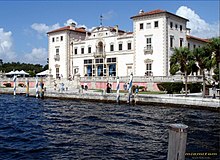
Miami is one of the country's most important financial centers. It is a major center of commerce, finances, corporate headquarters, and boasts a strong international business community. According to the ranking of world cities undertaken by the Globalization and World Cities Study Group & Network (GaWC) and based on the level of presence of global corporate service organizations, Miami is considered a "beta world city".[5]
Several large companies are headquartered in or around Miami, including but not limited to: Alienware, Arquitectonica, Arrow Air, Bacardi, Benihana, Brightstar Corporation, Burger King, Celebrity Cruises, Carnival Corporation, Carnival Cruise Lines, CompUSA, Crispin Porter + Bogusky, Espírito Santo Financial Group, Fizber.com, Greenberg Traurig, Interval International, Lennar, Norwegian Cruise Lines, Perry Ellis International, RCTV International, Royal Caribbean Cruise Lines, Ryder Systems, Seabourn Cruise Line, Telefónica USA, TeleFutura, Telemundo, Univision, U.S. Century Bank, and World Fuel Services. Because of its proximity to Latin America, Miami serves as the headquarters of Latin American operations for more than 1400 multinational corporations, including AIG, American Airlines, Cisco, Disney, Exxon, FedEx, Kraft Foods, Microsoft, Oracle, SBC Communications, Sony, Visa International, and Wal-Mart.[16]
Since 2001, Miami has been undergoing a large building boom with more than 50 skyscrapers rising over 400 feet (122 m) built or currently under construction in the city. Miami's skyline is ranked third most impressive in the U.S., behind New York City and Chicago, and 18th in the world according to the Almanac of Architecture and Design.[17] The city currently has the eight tallest (as well as thirteen of the fourteen tallest) skyscrapers in the state of Florida, with the tallest being the 789-foot (240 m) Four Seasons Hotel & Tower.[18]
Miami International Airport and the Port of Miami are among the nation's busiest ports of entry, especially for cargo from South America and the Caribbean. Additionally, Downtown has the largest concentration of international banks in the country located mostly in Brickell, Miami's financial district. Miami was also the host city of the 2003 Free Trade Area of the Americas negotiations, and is one of the leading candidates to become the trading bloc's headquarters. Tourism is also an important industry in Miami. The beaches, conventions, festivals and events draw over 12 million visitors annually from across the country and around the world, spending $17.1 billion.[19] The historical Art Deco district in South Beach, is widely regarded as one of the most glamorous in the world for its world-famous nightclubs, beaches, historical buildings, and shopping. However, it is important to note that Miami Beach is a separate city from the City of Miami.
Miami is the home to the National Hurricane Center and the headquarters of the United States Southern Command, responsible for military operations in Central and South America. In addition to these roles, Miami is also an industrial center, especially for stone quarrying and warehousing.
According to the U.S. Census Bureau, in 2004, Miami had the third highest incidence of family incomes below the federal poverty line in the United States, making it the third poorest city in the USA, behind only Detroit, Michigan (ranked #1) and El Paso, Texas (ranked #2.) Miami is also one of the very few cities where its local government went bankrupt, in 2001.[20] However, since that time, Miami has experienced a revival: in 2008, Miami was ranked as "America's Cleanest City" according to Forbes Magazine for its year-round good air quality, vast green spaces, clean drinking water, clean streets and city-wide recycling programs.[21] In a 2009, UBS study of 73 world cities, Miami was ranked as the richest city in the United States (of four U. S. cities included in the survey) and the world's fifth-richest city, in terms of purchasing power.[22]
In 2005, the Miami area witnessed its largest real estate boom since the 1920s. Midtown, having well over a hundred approved construction projects, is an example of this.[23] As of 2007, however, the housing market has crashed and more than 23,000 condos are for sale and/or foreclosed.[24] The Miami area ranks 8th in the nation in foreclosures.[25]
Geography
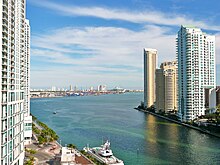
At only 35.68 square miles (92 km2) of land area, Miami has the smallest land area of any major U.S. city with a metro area of at least 2.5 million people. The city proper is home to less than 1 in 13 residents of South Florida. Additionally, 52% of Miami-Dade County's population doesn't live in any incorporated city. Miami is the only major city in the United States bordered by two national parks, Everglades National Park on the west, and Biscayne National Park on the east.
Miami and its suburbs are located on a broad plain between the Florida Everglades to the west and Biscayne Bay to the east that also extends from Florida Bay north to Lake Okeechobee. The elevation of the area never rises above 40 ft (12 m)[26] and averages at around 6 ft (1.8 m)[27] above mean sea level in most neighborhoods, especially near the coast. The highest undulations are found along the coastal Miami Rock Ridge, whose substrate underlies most of the eastern Miami metropolitan region. The main portion of the city lies on the shores of Biscayne Bay which contains several hundred natural and artificially created barrier islands, the largest of which contains Miami Beach and South Beach. The Gulf Stream, a warm ocean current, runs northward just 15 miles (24 kilometres) off the coast, allowing the city's climate to stay warm and mild all year.
Geology

The surface bedrock under the Miami area is called Miami oolite or Miami limestone. This bedrock is covered by a thin layer of soil, and is no more than 50 feet (15 metres) thick. Miami limestone formed as the result of the drastic changes in sea level associated with recent glaciations or ice ages. Beginning some 130,000 years ago the Sangamonian Stage raised sea levels to approximately 25 feet (7.6 metres) above the current level. All of southern Florida was covered by a shallow sea. Several parallel lines of reef formed along the edge of the submerged Florida plateau, stretching from the present Miami area to what is now the Dry Tortugas. The area behind this reef line was in effect a large lagoon, and the Miami limestone formed throughout the area from the deposition of oolites and the shells of bryozoans. Starting about 100,000 years ago the Wisconsin glaciation began lowering sea levels, exposing the floor of the lagoon. By 15,000 years ago, the sea level had dropped to 300 to 350 feet (110 m) below the contemporary level. The sea level rose quickly after that, stabilizing at the current level about 4000 years ago, leaving the mainland of South Florida just above sea level.
Beneath the plain lies the Biscayne Aquifer,[29] a natural underground source of fresh water that extends from southern Palm Beach County to Florida Bay, with its highest point peaking around the cities of Miami Springs and Hialeah. Most of the South Florida metropolitan area obtains its drinking water from this aquifer. As a result of the aquifer, it is not possible to dig more than 15 to 20 ft (4.6 to 6.1 m) beneath the city without hitting water, which impedes underground construction. For this reason, the mass transit systems in and around Miami are elevated or at-grade.
Most of the western fringes of the city extend into the Everglades, a subtropical marshland located in the southern portion of the U.S. state of Florida. This causes occasional problems with local wildlife such as alligators venturing into Miami communities and major highways.
In terms of land area, Miami is one of the smallest major cities in the United States. According to the US Census Bureau, the city encompasses a total area of 55.27 sq mi (143.1 km2). Of that area, 35.67 sq mi (92.4 km2) is land and 19.59 sq mi (50.7 km2) is water. That means Miami comprises over 400,000 people in a mere 35 square miles (91 km2), making it one of the most densely populated cities in the United States, along with New York City, San Francisco, and Chicago among others. Miami is located at 25°47′16″N 80°13′27″W / 25.78778°N 80.22417°W.Template:GR
Climate
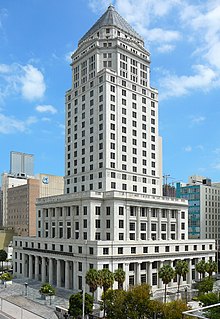


Miami tropical monsoon climate (Köppen climate classification Am)[30] with hot and humid summers and short, warm winters, with a marked dry season in the winter. Its sea-level elevation, coastal location, position just above the Tropic of Cancer, and proximity to the Gulf Stream shapes its climate. With January averaging 67.2 °F (19.6 °C), winter features mild to warm temperatures; cool air usually settles after the passage of a cold front, which produces much of the little amount of rainfall. Lows sometimes fall below 50 °F (10 °C), but very rarely below 40 °F (4 °C). Highs generally range between 70–77 °F (21–25 °C). The wet season begins some time in May, ending in mid-October. During this period, temperatures are in the mid 80s to low 90s (29–35 °C), accompanied by high humidity, though the heat is often relieved by afternoon thunderstorms or a sea breeze that develops off the Atlantic Ocean, which then allow lower temperatures, but conditions still remain very muggy. Much of the year's 55.9 inches (1,420 mm) of rainfall occurs during this period.
Extremes range from 30 °F (−1.1 °C) to 98 °F (37 °C).[31][32] Miami has never recorded an accumulation of snow, and has only once recorded snow flurries, on January 19, 1977.
Hurricane season officially runs from June 1 through November 30, although hurricanes can develop beyond those dates. The most likely time for Miami to be hit is during the peak of the Cape Verde season which is mid-August through the end of September.[33]
| Month | Jan | Feb | Mar | Apr | May | Jun | Jul | Aug | Sep | Oct | Nov | Dec | Year |
|---|---|---|---|---|---|---|---|---|---|---|---|---|---|
| Record high °F (°C) | 88 (31) |
89 (32) |
93 (34) |
97 (36) |
98 (37) |
98 (37) |
100 (38) |
98 (37) |
97 (36) |
95 (35) |
91 (33) |
89 (32) |
100 (38) |
| Mean maximum °F (°C) | 84.4 (29.1) |
85.8 (29.9) |
89.0 (31.7) |
90.7 (32.6) |
92.8 (33.8) |
94.2 (34.6) |
94.7 (34.8) |
94.5 (34.7) |
93.2 (34.0) |
90.9 (32.7) |
87.0 (30.6) |
84.9 (29.4) |
95.8 (35.4) |
| Mean daily maximum °F (°C) | 76.2 (24.6) |
78.2 (25.7) |
80.6 (27.0) |
83.6 (28.7) |
86.7 (30.4) |
89.3 (31.8) |
90.6 (32.6) |
90.7 (32.6) |
89.0 (31.7) |
85.9 (29.9) |
81.3 (27.4) |
78.2 (25.7) |
84.2 (29.0) |
| Daily mean °F (°C) | 68.6 (20.3) |
70.7 (21.5) |
73.1 (22.8) |
76.7 (24.8) |
80.1 (26.7) |
82.8 (28.2) |
84.1 (28.9) |
84.2 (29.0) |
83.0 (28.3) |
80.1 (26.7) |
74.8 (23.8) |
71.2 (21.8) |
77.4 (25.2) |
| Mean daily minimum °F (°C) | 61.0 (16.1) |
63.2 (17.3) |
65.6 (18.7) |
69.8 (21.0) |
73.4 (23.0) |
76.3 (24.6) |
77.5 (25.3) |
77.7 (25.4) |
76.9 (24.9) |
74.2 (23.4) |
68.3 (20.2) |
64.3 (17.9) |
70.7 (21.5) |
| Mean minimum °F (°C) | 45.1 (7.3) |
48.5 (9.2) |
52.3 (11.3) |
59.6 (15.3) |
66.7 (19.3) |
71.5 (21.9) |
72.5 (22.5) |
72.8 (22.7) |
72.7 (22.6) |
65.0 (18.3) |
55.7 (13.2) |
49.7 (9.8) |
42.5 (5.8) |
| Record low °F (°C) | 28 (−2) |
27 (−3) |
32 (0) |
39 (4) |
50 (10) |
60 (16) |
66 (19) |
67 (19) |
62 (17) |
45 (7) |
36 (2) |
30 (−1) |
27 (−3) |
| Average precipitation inches (mm) | 1.83 (46) |
2.15 (55) |
2.46 (62) |
3.36 (85) |
6.32 (161) |
10.51 (267) |
7.36 (187) |
9.58 (243) |
10.22 (260) |
7.65 (194) |
3.53 (90) |
2.44 (62) |
67.41 (1,712) |
| Average precipitation days (≥ 0.01 in) | 7.7 | 6.5 | 6.3 | 6.9 | 10.8 | 17.6 | 17.3 | 19.4 | 18.1 | 13.8 | 8.6 | 8.0 | 141.0 |
| Average relative humidity (%) | 72.7 | 70.9 | 69.5 | 67.3 | 71.6 | 76.2 | 74.8 | 76.2 | 77.8 | 74.9 | 73.8 | 72.5 | 73.2 |
| Average dew point °F (°C) | 57.6 (14.2) |
57.6 (14.2) |
60.4 (15.8) |
62.6 (17.0) |
67.6 (19.8) |
72.0 (22.2) |
73.0 (22.8) |
73.8 (23.2) |
73.2 (22.9) |
68.7 (20.4) |
63.9 (17.7) |
59.2 (15.1) |
65.8 (18.8) |
| Mean monthly sunshine hours | 219.8 | 216.9 | 277.2 | 293.8 | 301.3 | 288.7 | 308.7 | 288.3 | 262.2 | 260.2 | 220.8 | 216.1 | 3,154 |
| Percent possible sunshine | 66 | 69 | 75 | 77 | 72 | 70 | 73 | 71 | 71 | 73 | 68 | 66 | 71 |
| Average ultraviolet index | 5.1 | 6.7 | 8.6 | 10.2 | 10.5 | 10.7 | 10.8 | 10.5 | 9.3 | 7.1 | 5.3 | 4.5 | 8.2 |
| Source 1: NOAA (relative humidity, dew point and sun 1961–1990),[34][35][36] The Weather Channel[37] | |||||||||||||
| Source 2: UV Index Today (1995 to 2022),[38] Thunderstorm days (1961 to 1990)[39] | |||||||||||||
Surrounding neighborhoods and areas
 Miami Springs, Brownsville, West Little River, El Portal, Miami Shores, North Miami, North Miami Beach, Aventura
Miami Springs, Brownsville, West Little River, El Portal, Miami Shores, North Miami, North Miami Beach, Aventura North Bay Village, Miami Beach
North Bay Village, Miami Beach Fisher Island, Key Biscayne, Biscayne Bay
Fisher Island, Key Biscayne, Biscayne Bay Coral Gables, West Miami, Coral Terrace, South Miami, Pinecrest, Palmetto Bay
Coral Gables, West Miami, Coral Terrace, South Miami, Pinecrest, Palmetto Bay Coral Gables, West Miami, Coral Terrace, Kendall, Kendale Lakes
Coral Gables, West Miami, Coral Terrace, Kendall, Kendale Lakes Coral Gables, Westchester, Fountainbleau, El Portal, Doral
Coral Gables, Westchester, Fountainbleau, El Portal, Doral Miami Springs, Miami Lakes, Hialeah, Brownsville, Gladeview, West Little River
Miami Springs, Miami Lakes, Hialeah, Brownsville, Gladeview, West Little River
Neighborhoods



Miami is partitioned into many different sections, roughly into North, South, West and Downtown. The heart of the city is Downtown Miami and is technically on the eastern side of the city. This area includes Brickell, Virginia Key, Watson Island, and the Port of Miami. Downtown is South Florida's central business district, and Florida's largest and most influential central business district. Downtown has the largest concentration of international banks in the U.S. along Brickell Avenue. Downtown is home to many major banks, courthouses, financial headquarters, cultural and tourist attractions, schools, parks and a large residential population. East of Downtown, across Biscayne Bay is South Beach.
The southern side of Miami includes Coral Way, The Roads and Coconut Grove. Coral Way is a historic residential neighborhood built in 1922 connecting Downtown with Coral Gables, and is home to many old homes and tree-lined streets. Coconut Grove was established in 1825 and is the location of Miami's City Hall in Dinner Key, the Coconut Grove Playhouse, CocoWalk, many nightclubs, bars, restaurants and bohemian shops, and as such, is very popular with local college students. It is a historic neighborhood with narrow, winding roads, and a heavy tree canopy. Coconut Grove has many parks and gardens such as Villa Vizcaya, The Kampong, The Barnacle Historic State Park, and is the home of the Coconut Grove Convention Center, as well as many of the country's most prestigious private schools, and numerous historic homes and estates.
The western side of Miami includes Little Havana, West Flagler, and Flagami, and is home to many of the city's traditionally immigrant neighborhoods. Although at one time a mostly Jewish neighborhood, today western Miami is home to immigrants from mostly Central America and Cuba, while the west central neighborhood of Allapattah is a multicultural community of many ethnicities.
The northern side of Miami includes Midtown, a district with a great mix of diversity with many West Indians, Hispanics, bohemians, artists, and Whites. Edgewater, and Wynwood, are neighborhoods of Midtown and are made up mostly of high-rise residential towers and are home to the Adrienne Arsht Center for the Performing Arts. The wealthier residents usually live in the northeastern part, in Midtown, the Design District, and the Upper East Side, with many sought after 1920s homes and home of the MiMo Historic District, a style of architecture originated in Miami in the 1950s. The northern side of Miami, also has notable African-American and Caribbean immigrant communities such as Little Haiti, Overtown (home of the Lyric Theater), and Liberty City.

Culture
Entertainment and performing arts
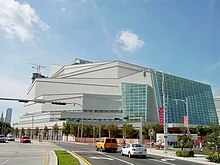
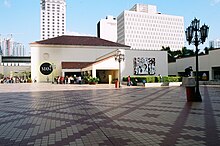
Miami is home to many entertainment venues, theaters, museums, parks and performing arts centers. The newest addition to the Miami arts scene is the Adrienne Arsht Center for the Performing Arts, the second-largest performing arts center in the United States after the Lincoln Center in New York City, and is the home of the Florida Grand Opera. Within it are the Ziff Ballet Opera House, the center's largest venue, the Knight Concert Hall, the Carnival Studio Theater and the Peacock Rehearsal Studio. The center attracts many large scale operas, ballets, concerts, and musicals from around the world and is Florida's grandest performing arts center. Other performing arts venues in Miami include the Gusman Center for the Performing Arts, Coconut Grove Playhouse, Colony Theatre, Lincoln Theatre, New World Symphony House, Actor's Playhouse at the Miracle Theatre, Jackie Gleason Theatre, Manuel Artime Theater, Ring Theatre, Playground Theatre, Wertheim Performing Arts Center, the Fair Expo Center and the Bayfront Park Amphitheater for outdoor music events.
The city is home to numerous museums as well, many of which are in Downtown. These include the Bass Museum, Frost Art Museum, Historical Museum of Southern Florida, Jewish Museum of Florida, Lowe Art Museum, Miami Art Museum, Miami Children's Museum, Miami Science Museum, Museum of Contemporary Art, Vizcaya Museum and Gardens, Wolfsonian-FIU Museum and the Miami Cultural Center, home of the Main Miami Library. Other popular cultural destinations in the area include Jungle Island, Miami Metrozoo, Miami Seaquarium, Coral Castle, St. Bernard de Clairvaux Church, Charles Deering Estate, and parks and gardens in and around the city; there are over 80 parks in Miami.[40] The largest and most popular parks are Bayfront Park and Bicentennial Park (located in the heart of Downtown and the location of the American Airlines Arena and Bayside Marketplace), Fairchild Tropical Botanic Garden, Tropical Park, Watson Island, Morningside Park and Key Biscayne.
Miami is also a major fashion center, home to models and some of the top modeling agencies in the world. Miami is also host to many fashion shows and events, including the annual Miami Fashion Week and the Mercedes-Benz Fashion Week Miami held in the Wynwood Art District.[41] Miami is also the home of the world's largest art exhibition, dubbed the "Olympics of Art", Art Basel Miami Beach. The event is held annually in December, and attracts thousands of visitors from around the world.
Music

Miami music is varied. Cubans brought the conga and rumba to Miami from their homelands instantly popularizing it in American culture. Dominicans brought bachata, and merengue, while Colombians brought vallenato and cumbia. West Indians and Caribbean people have brought reggae, soca, kompa, zouk, calypso, and steel pan to the area as well.
In the early 1970s, the Miami disco sound came to life with TK Records, featuring the music of KC and the Sunshine Band, with such hits as "Get Down Tonight", "(Shake, Shake, Shake) Shake Your Booty" and "That's the Way (I Like It)"; and the Latin-American disco group, Foxy (band), with their hit singles "Get Off" and "Hot Number". Miami-area natives George McCrae and Teri DeSario were also popular music artists during the 1970s disco era. The Bee Gees moved to Miami in 1975 and have lived here ever since then. Miami-influenced, Gloria Estefan and the Miami Sound Machine, hit the popular music scene with their Cuban-oriented sound and had huge hits in the 1980s with "Conga" and "Bad Boys".

Miami is also considered a "hot spot" for dance music, Freestyle, a style of dance music popular in the 80's and 90's heavily influenced by Electro, hip-hop, and disco. Many popular Freestyle acts such as Pretty Tony, Debbie Deb, Stevie B, and Exposé, originated in Miami. Indie/folk acts Cat Power and Iron & Wine are based in the city,[42] while alternative hip hop artist Sage Francis, electro artist Uffie, and the electroclash duo Avenue D were born in Miami, but musically based elsewhere. Also, punk band Against All Authority is from Miami, and rock/metal bands Nonpoint and Marilyn Manson each formed in neighboring Fort Lauderdale. Popular Cuban American female recording artist, Ana Cristina, was born in Miami in 1985, and became the first Hispanic person in history to perform the "Star Spangled Banner" at a presidential inauguration.
The 80's and 90's also brought the genre of high energy Miami Bass to dance floors and car subwoofers throughout the country. Miami Bass spawned artists like 2 Live Crew (featuring Uncle Luke), 95 South, Tag Team, 69 Boyz, Quad City DJ's, and Freak Nasty. Examples of these songs are "Whoomp! (There It Is)" by Tag Team in 1993, "Tootsee Roll" by 69 Boyz in 1994, and "C'mon N' Ride It (The Train)" by the Quad City DJ's in 1996. These songs all reached the top 10 in the pop charts and gave Miami Bass a new commercial success.
Miami is also home to a vibrant techno and dance scene and hosts the Winter Music Conference, the largest dance event in the world, Ultra Music Festival and many electronica music-themed celebrations and festivals. Along with neighboring Miami Beach, Miami is home to some famous nightclubs, such as Space, Mansion, Parkwest, Ink, and Cameo. The city is known to be part of clubland, along with places such as Mykonos, Ibiza and Ayia Napa.
There are also several rap and hip hop artists out of Miami. They include Trick Daddy, Trina, Pitbull, Jackie-O, Rick Ross, and legendary Miami Bass group, 2 Live Crew
Media


Miami has one of the largest media market in the nation and the second highest in the state of Florida.[43] Miami has several major newspapers, the main and largest newspaper being The Miami Herald. El Nuevo Herald is the major and largest Spanish-language newspaper. Both The Miami Herald and El Nuevo Herald are Miami's and South Florida's main, major and largest newspapers and are both headquartered in Downtown Miami in Herald Plaza.
Other major newspapers include Miami Today, headquartered in Brickell, Miami New Times, headquartered in Midtown, Miami Sun Post, South Florida Business Journal, Miami Times, and Biscayne Boulevard Times. An additional Spanish-language newspapers, Diario Las Americas also serve Miami. The Miami Herald is Miami's primary newspaper with over a million readers and is headquartered in Downtown in Herald Plaza. Several other student newspapers from the local universities, such as Florida International University's The Beacon, the University of Miami's The Miami Hurricane, Miami-Dade College's The Metropolis, Barry University's The Buccaneer, amongst others. Many neighborhoods and neighboring areas also have their own local newspapers such as the Coral Gables Tribune, Biscayne Bay Tribune, and the Palmetto Bay News.
A number of magazines circulate throughout the greater Miami area, including Miami Monthly, Southeast Florida's only city/regional; Ocean Drive, a hot-spot social scene glossy, and South Florida Business Leader.
Miami is also the headquarters and main production city of many of the world's largest television networks, record label companies, broadcasting companies and production facilities, such as Telemundo, TeleFutura, Galavisión, Mega TV, Univisión, Univision Communications, Inc., Universal Music Latin Entertainment, RCTV International and Sunbeam Television. In 2009, Univisión announced plans to build new production studios in Miami, dubbed 'Univisión Studios'. Univisión Studios will be headquartered in Miami, and will produce programming for all of Univisión Communications' television networks.[44]
Miami is the twelfth largest radio market[45] and the seventeenth largest television market[46] in the United States. Television stations serving the Miami area include: WAMI (Telefutura), WBFS (My Network TV), WSFL (The CW), WFOR (CBS), WHFT (TBN), WLTV (Univision), WPLG (ABC), WPXM (ION), WSCV (Telemundo), WSVN (Fox), WTVJ (NBC), WPBT (PBS), and WLRN (also PBS).
Accent
In Miami, a unique accent, commonly called the "Miami accent", is widely spoken. It developed mostly by second- or third-generation Hispanics whose first language was English. It is very similar to accents in the Northeast, but contains a rhythm and pronunciation heavily influenced by Spanish. However, a Miami accent is not Spanish-accented English, as many Miami residents who are not Hispanic, or do not speak Spanish, speak with the Miami accent as well. It is most common amongst those born and raised in Miami, and can commonly be heard in Blacks and White non-Hispanics, as well as in Hispanics. However, not all Miamians have the accent. The accent is acquired in some areas, but not others.[citation needed]
Sports

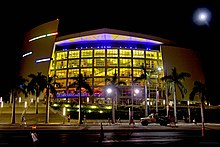
The Miami Dolphins, the NFL team, Miami Heat, the NBA team, Florida Marlins, the MLB team, and the Florida Panthers, Miami's NHL team. As well as having all four major professional teams, Miami is also home to Miami FC, Miami Tropics, the Sony Ericsson Open for professional tennis, numerous greyhound racing tracks, marinas, Jai-Alai venues, and golf courses.
The Miami Heat is the only major professional sports team that plays its games within Miami's city limits at the American Airlines Arena. The team recently won the 2006 NBA Finals, winning the series 4-2 over the Dallas Mavericks. The Miami Dolphins and the Florida Marlins both play their games in Miami Gardens. The Orange Bowl, a member of the Bowl Championship Series, hosts their college football championship games at Sun Life Stadium. The stadium has also hosted the Super Bowl; the Miami metro area has hosted the game a total of nine times (four Super Bowls in Dolphin Stadium, including Super Bowl XLI and five at the Miami Orange Bowl), tying New Orleans for the most games.
Miami FC, Florida's only professional soccer team, plays at Tropical Park Stadium. Miami signed world-famed soccer player Romario in March 2006 to a one year deal. The Florida Panthers NHL team plays in neighboring Broward County, Florida at the BankAtlantic Center in the city of Sunrise. Miami is also home to Paso Fino horses, where competitions are held at Tropical Park Equestrian Center.
Miami is also the home of many college sports teams. The two largest are the Florida International University Golden Panthers whose football team plays at FIU Stadium and the University of Miami Hurricanes, whose football team formerly played at the Miami Orange Bowl, but moved to Sun Life Stadium starting with the 2008 season.
A number of defunct teams were located in Miami, including the Miami Floridians (ABA), Miami Matadors (ECHL), Miami Manatees (WHA2), Miami Gatos (NASL), Miami Screaming Eagles (WHA), Miami Seahawks (AAFC), Miami Sol (WNBA), Miami Toros (NASL), Miami Tropics (SFL), Miami Tropics (ABA), and the Miami Hooters (Arena Football League). The Miami Fusion, a defunct Major League Soccer team played at Lockhart Stadium in nearby Broward County.
| Club | Sport | League | Venue | League Championships |
|---|---|---|---|---|
| Miami Dolphins | Football | National Football League; AFC | Sun Life Stadium | Super Bowl (2)
|
| Florida Panthers | Hockey | National Hockey League | BankAtlantic Center | none |
| Miami Heat | Basketball | National Basketball Association | American Airlines Arena | NBA Finals (1)
|
| Florida Marlins | Baseball | Major League Baseball; NL | Sun Life Stadium | World Series (2)
|
| Miami FC | Soccer | United Soccer League First Division | Tropical Park Stadium | none |
| College / Athletics | Football | Football venue |
Basketball | Basketball venue |
Conference | National Championships (Most Recent) |
|---|---|---|---|---|---|---|
| FIU Golden Panthers | FIU football | FIU Stadium | FIU basketball | U.S. Century Bank Arena | Sun Belt Conference | 4 (1984 – Men's Soccer) |
| Miami Hurricanes | Miami football | Sun Life Stadium | Miami basketball | BankUnited Center | Atlantic Coast Conference | 30 (2001 – Football & Baseball) |
| Barry Buccaneers | – | – | Barry basketball | Health & Sports Center | Sunshine State Conference | 7 (2007 – Men's Golf) |
| NSU Sharks | – | – | NSU basketball | Don Taft UC Arena | Sunshine State Conference | 11 (2009 – Women's Golf & Women's Rowing) |
Notable People
Demographics
| Miami population | ||
| Year | City proper[48] |
Metro area[49] |
|---|---|---|
| 1900 | 1,681 | N/A |
| 1910 | 5,471 | N/A |
| 1920 | 29,549 | 66,542 |
| 1930 | 110,637 | 214,830 |
| 1940 | 172,172 | 387,522 |
| 1950 | 249,276 | 693,705 |
| 1960 | 291,688 | 1,497,099 |
| 1970 | 334,859 | 2,236,645 |
| 1980 | 346,865 | 3,220,844 |
| 1990 | 358,548 | 4,056,100 |
| 2000 | 362,470 | 5,007,564 |
| 2007 | 424,662 | 5,413,212 |
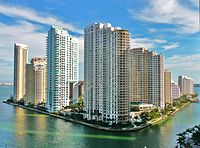
Miami is the 43rd most populous city in the U.S. The Miami metropolitan area, which includes Miami-Dade, Broward and Palm Beach counties, had a combined population of more than 5.4 million people, ranked seventh largest in the United States,[50] (behind Houston), and is the largest metropolitan area in the Southeastern United States. As of 2008, the United Nations estimates that the Miami Urban Agglomeration is the 44th-largest in the world.[51] As of the census of 2000, there were 362,470 people, 134,198 households, and 83,336 families residing in the city. The population density was 10,160.9/mi² (3,923.5/km2). There were 148,388 housing units at an average density of 4,159.7/mi² (1,606.2/km2).
The racial makeup of the city proper is as follows:[52]
- White: 66.6% (Non-Hispanic White 11.8%)
- Hispanic or Latino of any race: 65.8%
- Black (many of whom are from the Caribbean) or African American: 22.3%
- Some other races: 5.4%
- Two or more races: 4.7%
- Asian: 0.7%
- Pacific Islander: 0.04%
- Native American: 0.2%
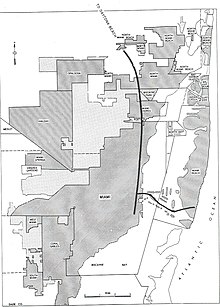
As of 2000, in terms of national origin and/or ethnic origin, 34.1% of the populace was Cuban,[53] while 5.6% of the city's population was Nicaraguan,[54] 5.5% of the population was Haitian,[55] 3.3% of the population was Honduran,[56] 1.7% of all residents were Dominican,[57] and 1.6% of the population was Colombian.[58] In 2004, the United Nations Development Program (UNDP) ranked Miami first in terms of percentage of residents born outside of the country it is located in (59%), followed by Toronto (50%).
There were 134,198 households out of which 26.3% had children under the age of 18 living with them, 36.6% were married couples living together, 18.7% have a female head of household with no husband present, and 37.9% were non-families. 30.4% of all households were made up of individuals and 12.5% had someone living alone who was 65 years of age or older. The average household size was 2.61 and the average family size was 3.25. The age distribution was 21.7% under the age of 18, 8.8% from 18 to 24, 30.3% from 25 to 44, 22.1% from 45 to 64, and 17.0% who were 65 years of age or older. The median age was 38 years. For every 100 females there were 98.9 males. For every 100 females age 18 and over, there were 97.3 males.
The median income for a household in the city was $23,483, and the median income for a family was $27,225. Males had a median income of $24,090 versus $20,115 for females. The per capita income for the city was $15,128. About 23.5% of families and 28.5% of the population were below the poverty line, including 38.2% of those under age 18 and 29.3% of those age 65 or over.
Miami's explosive population growth in recent years has been driven by internal migration from other parts of the country as well as by immigration. Miami is regarded as more of a multicultural mosaic, than it is a melting pot, with residents still maintaining much of, or some of their cultural traits. The overall culture of Miami is heavily influenced by its large population of Latinos, and Blacks, mainly from the Caribbean, from islands such as Jamaica, Haiti, Trinidad and Tobago, and The Bahamas.

Today, the Miami area has a sizable community of citizens, undocumented populations, and permanent residents, of Argentines, Bahamians, Barbadian, Bolivians, Brazilians, Canadians, Chileans, Chinese, Colombians, Costa Ricans, Cubans, Dominicans, Ecuadorans, French, Germans, Greeks, Guatemalans, Guayanese, Haitians, Hondurans, Jamaicans, Koreans, Indians, Italians, Mexicans, Nicaraguans, Panamanians, Peruvians, Russians, Salvadoran, Spanish, Trinidadians and Tobagonians, Turks, South Africans, and Venezuelans, and Puerto Ricans. [citation needed] While commonly thought of as a city mainly of Latino and Black Caribbean immigrants, the Miami area is home to large French, French Canadian, German, Italian, and Russian communities. [citation needed]The communities have grown to a prominent place in Miami and its suburbs, creating ethnic enclave neighborhoods such as Little Buenos Aires, Little Haiti, Little Havana, Little Managua, Little Brazil, Little Moscow, Little San Juan, and Little Tel Aviv.[citation needed]
Languages
As of 2000, speakers of Spanish as their first language accounted for 66.75% of residents, while English was spoken by 25.45%, Haitian Creole by 5.20%, and French speakers comprised 0.76% of the population.[59] Other languages that were spoken throughout the city include Portuguese at 0.41%, German at 0.18%, Italian at 0.16%, Arabic at 0.15%, Chinese at 0.11%, and Greek at 0.08% of the population. Miami also has one of the largest percentage populations in the U.S. that have residents who speak first languages other than English at home (74.55%).[59]
Due to the increase in Spanish-speaking residents, by 2008 some English-speakers felt marginalized due to difficulties in conducting business.[60]
Government

The government of the City of Miami, Florida, uses the mayor-city commissioner system. The city commission consists of five commissioners, are elected from single member districts. The city commission constitutes the governing body with powers to pass ordinances adopt regulations and exercise all powers conferred upon the city in the city charter.The mayor is elected at large and appoints a city manager. The City of Miami is governed by Mayor Tomás Regalado and 5 City commissioners which oversee the five districts in the City. It holds regular meetings in the City Hall of Miami located in 3500 Pan American Drive Miami, Florida 33133 in the neighborhood of Coconut Grove on Dinner Key.
City council
- Tomás Regalado – Mayor of the City of Miami
- Wifredo "Willy" Gort – City of Miami Commissioner, District 1
- Marc Sarnoff – City of Miami Commissioner, District 2
- Frank Carollo – City of Miami Commissioner, District 3
- Francis Suarez – City of Miami Commissioner, District 4
- Richard P. Dunn – City of Miami Commissioner, District 5
City management
- Pedro G. Hernandez – City Manager
- Julie O. Bru – City Attorney
- Priscilla Thompson – City Clerk
Education
Public schools

Public schools in Miami are governed by Miami-Dade County Public Schools, which is the largest school district in Florida and the fourth-largest in the United States. As of September 2008 it has a student enrollment of 385,655 and over 392 schools and centers. The district is also the largest minority public school system in the country, with 60% of its students being of Hispanic origin, 28% African American, 10% White (non-Hispanic) and 2% non-white of other minorities.[61] Miami is home to some of the nation's best high schools, such as Design and Architecture High School, ranked the nation's best magnet school, MAST Academy, Coral Reef High School, ranked 20th-best public high school in the U.S., Miami Palmetto High School, and the New World School of the Arts.[62] M-DCPS is also one of a few public school districts in the United States to offer optional bilingual education in Spanish, Haitian Creole, and Mandarin Chinese.
Private schools
Miami is home to several prestigious Roman Catholic, Jewish and non-denominational private schools. The Archdiocese of Miami operates the city's Catholic private schools, which include: Our Lady of Lourdes Academy, St. Hugh Catholic School, St. Agatha Catholic School, St. Theresa School, La Salle High School, Monsignor Edward Pace High School, Carrollton School of the Sacred Heart, Christopher Columbus High School, Archbishop Curley-Notre Dame High School, St. Brendan High School, amongst numerous other elementary and high schools. Some of the most well-known non-denominational private schools in Miami are Ransom Everglades, Gulliver Preparatory School, and Miami Country Day School, which are traditionally known as some of the country's best schools. Other schools in the outlying areas include Belen Jesuit Preparatory School and Samuel Scheck Hillel Community Day School.
Colleges and universities
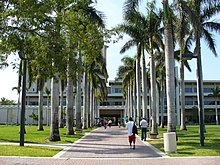
(List includes institutions in and around Miami.)
- Barry University (private)
- Carlos Albizu University (private)
- Florida International University (FIU) (public, largest university in South Florida)
- Florida Memorial University (private)
- Johnson and Wales University (private)
- Keiser University (private)
- Miami Dade College (public, largest institution of higher learning in the U.S.)
- Miami International University of Art & Design (private)
- Nova Southeastern University (private)
- St. Thomas University (private)
- Sullivan and Cogliano Training Centers (private)
- Talmudic University (private)
- University of Miami (private, located in Coral Gables)
The city ranks second-to-last in people over 18 with a high school diploma, with 47% of the population not having that degree.[63]
Transportation
Airports

Miami International Airport, located in an unincorporated area in the county, serves as the primary international airport of the Miami Area. One of the busiest international airports in the world, Miami International Airport caters to over 35 million passengers a year. Identifiable locally, as well as several worldwide authorities, as MIA or KMIA, the airport is a major hub and the single largest international gateway for American Airlines, the world's largest passenger air carrier. Miami International is the busiest airport in Florida, and is the United States' second-largest international port of entry for foreign air passengers behind New York's John F. Kennedy International Airport, and is the seventh-largest such gateway in the world. The airport's extensive international route network includes non-stop flights to over seventy international cities in North and South America, Europe, Asia, and the Middle East.
Alternatively, nearby Fort Lauderdale-Hollywood International Airport also serves commercial traffic in the Miami area.[64] Opa-Locka Airport in Opa-Locka and Kendall-Tamiami Airport in an unincorporated area serve general aviation traffic in the Miami area.
Port of Miami

Miami is home to one of the largest ports in the United States, the Port of Miami. It is the largest cruise ship port in the world. The port is often called the "Cruise Capital of the World" and the "Cargo Gateway of the Americas".[65] It has retained its status as the number one cruise/passenger port in the world for well over a decade accommodating the largest cruise ships and the major cruise lines. In 2007, the port served 3,787,410 passengers.[66] Additionally, the port is one of the nation's busiest cargo ports, importing 7.8 million tons of cargo in 2007.[66] Among North American ports, it ranks second only to the Port of South Louisiana in New Orleans in terms of cargo tonnage imported/exported from Latin America. The port is on 518 acres (2 km2) and has 7 passenger terminals. China is the port's number one import country, and Honduras is the number one export country. Miami has the world's largest amount of cruise line headquarters, home to: Carnival Cruise Lines, Celebrity Cruises, Costa Cruises, Crystal Cruises, Norwegian Cruise Line, Oceania Cruises, Royal Caribbean International, and Windjammer Barefoot Cruises.
Public transportation
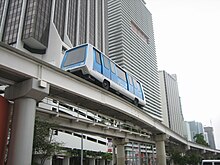
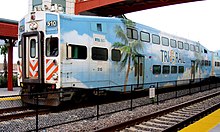
Public transportation in Miami is operated by Miami-Dade Transit and SFRTA, and includes commuter rail (Tri-Rail), heavy-rail rapid transit (Metrorail), an elevated people mover (Metromover), and buses (Metrobus). Miami has Florida's highest transit ridership as about 17% of Miamians use transit on a daily basis.[67]
Miami's heavy-rail rapid transit system, Metrorail, is an elevated system comprising 22 stations on a 22-mile (36-km)-long line. Metrorail runs from the western suburbs of Hialeah and Medley through the Civic Center, Downtown, Brickell, Coconut Grove, Coral Gables, South Miami and ends in the southern suburban neighborhood of Dadeland; construction on a direct Metrorail connection to Miami International Airport began in 2009 with expected passenger service beginning in early 2012.[68] A free, elevated people mover, Metromover, operates 21 stations on three different lines in Downtown, with a station at roughly every two blocks of Downtown and Brickell. Several expansion projects are being funded by a transit development sales tax surcharge throughout Miami-Dade County.
Tri-Rail, a commuter rail system operated by the South Florida Regional Transportation Authority (SFRTA), runs from Miami International Airport northward to West Palm Beach, making eighteen stops throughout Miami-Dade, Broward, and Palm Beach counties.
Construction is currently underway on the Miami Intermodal Center and Miami Central Station, a massive transportation hub servicing Metrorail, Amtrak, Tri-Rail, Metrobus, Greyhound Lines, taxis, rental cars, MIA Mover, private automobiles, bicycles and pedestrians adjacent to Miami International Airport. Completion of the Miami Intermodal Center is expected to be completed by 2010, and will serve over 150,000 commuters and travelers in the Miami area. Phase I of Miami Central Station is scheduled to be completed in June 2010, and Phase II in 2011.
Two new light rail systems, Baylink and the Miami Streetcar, have been proposed and are currently in the planning stage. BayLink would connect Downtown with South Beach, and the Miami Streetcar would connect Downtown with Midtown.
Rail


Miami is the southern terminus of Amtrak's Atlantic Coast services, running two lines, the Silver Meteor and the Silver Star, both terminating in New York City. The Miami Amtrak Station is located in the suburb of Hialeah near the Tri-Rail/Metrorail Station on NW 79 St and NW 38 Ave. Current construction of the Miami Central Station will move all Amtrak operations from its current out-of-the-way location to a centralized location with Metrorail, MIA Mover, Tri-Rail, Miami International Airport, and the Miami Intermodal Center all within the same station closer to Downtown. The station is expected to be completed by 2011.[69]
Future Florida rail plans could bring high-speed rail to Miami, connecting Miami with Orlando and Tampa in a single high-speed rail line. The Tampa-Orlando segment was approved by the federal government in 2009, and is set to start construction with an expected completion date of 2014. High-speed rail to Miami is planned to be completed by 2018, and would connect at the Miami Central Station.[70] Other rail plans include the re-opening of the Florida East Coast Railway connecting Miami to Jacksonville up along the Atlantic coast of Florida[71]
Road
Miami's road system is based along the numerical "Miami Grid" where Flagler Street forms the east-west axis, "streets", and Miami Avenue forms the north-south axis, "avenues". The corner of Flagler Street and Miami Avenue is in the middle of Downtown in front of the Downtown Macy's (formerly the Burdine's headquarters). The Miami grid is primarily numerical so that, for example, all street addresses north of Flagler Street and west of Miami Avenue have "NW" in their address. Because its point of origin is in Downtown which is close to the coast, therefore, the "NW" and "SW" quadrants are much larger than the "SE" and "NE" quadrants. Many roads, especially major ones, are also named (i.e.: Tamiami Trail/SW 8th St), although, with a few notable exceptions (i.e.: Coral Way), the number is in more common usage among locals.
All streets and avenues in Miami-Dade County follow the Miami Grid, with a few exceptions, most notably Coral Gables, Hialeah, and Miami Beach. Some neighborhoods, such as The Roads, is thusly named because its streets run off the Miami Grid in a 45-degree angle, and therefore all named 'roads'.
Miami-Dade County is served by four Interstate Highways (I-75, I-95, I-195, I-395) and several U.S. Highways including U.S. Route 1, U.S. Route 27, U.S. Route 41, and U.S. Route 441.
Some of the major Florida State Roads (and their common names) serving Miami are:
- SR 112 (Airport Expressway): Interstate 95 to MIA
- SR 821 (The HEFT or Homestead Extension of the Florida Turnpike): SR 91/Miami Gardens to U.S. Route 1/Florida City)
- SR 826 (Palmetto Expressway): Golden Glades Interchange to U.S. Route 1/Pinecrest
- SR 836 (Dolphin Expressway): Downtown to SW 137th Ave via MIA
- SR 874 (Don Shula Expressway): 826/Bird Road to Homestead Extension of Florida's Turnpike/Kendall
- SR 878 (Snapper Creek Expressway): SR 874/Kendall to U.S. Route 1/Pinecrest & South Miami
- SR 924 (Gratigny Parkway) Miami Lakes to Opa-locka
Miami has six major causeways that span over Biscayne Bay connecting the western mainland, with the eastern barrier islands along the Atlantic Ocean. The Rickenbacker Causeway is the southernmost causeway and connects Brickell to Virginia Key and Key Biscayne. The Venetian Causeway and MacArthur Causeway connect Downtown with South Beach. The Julia Tuttle Causeway connects Midtown and Miami Beach. The 79th Street Causeway connects the Upper East Side with North Beach. The northernmost causeway, the Broad Causeway, is the smallest of Miami's six causeways, and connects North Miami with Bal Harbour.
In 2007, Miami was identified as having the rudest drivers in the United States, the second year in a row to have been cited, in a poll commissioned by automobile club AutoVantage.[72] Miami is also consistently ranked as one of the most dangerous cities in the United States for pedestrians.[73]
Bicycling
In recent years, the city government under Mayor Manny Diaz, has taken an ambitious stance in support of bicycling in Miami for both recreation and commuting. Every month, the city hosts "Bike Miami", where major streets in Downtown and Brickell are closed to automobiles, and left open for pedestrians and bicyclists. The event began in November 2008, and has doubled in popularity from 1,500 participants to about 3,000 in the October 2009 Bike Miami. This is the longest running such event in the U.S. In October 2009, the city also approved an extensive 20-year plan for bike routes and paths around the city. The city has begun construction of bike routes as of late 2009, and ordinances requiring bike parking in all future construction in the city is now mandatory as of October 2009.[74]
In 2010, Miami was ranked #44 most bike-friendly city in the U.S. according to Bicycling Magazine.[75]
In popular culture

Many television shows have been set or are filmed in Miami. The controversial Emmy winning drama Nip/Tuck, CBS's CSI: Miami and Miami Medical, USA's Burn Notice and Showtime's Dexter all take place in Miami. The Jackie Gleason Show was taped in Miami Beach from 1964 to 1970. The NBC show Good Morning, Miami was fictionally based on the workings of a Miami television station. The popular sitcoms The Golden Girls and Empty Nest were based in Miami. Miami Vice was also based and filmed in the Miami area. Keeping with its modern music tradition, the city has recently hosted the 2004 and 2005 MTV Video Music Awards. Other music award shows to be hosted in Miami, are the Latin Grammys in 2003 and Lo Nuestro Awards in 2006.
In the mid-2000s, Miami started to become a popular backdrop for reality television shows. Reality programming set in the city include the TLC show Miami Ink; Discovery Channel's After Dark; Animal Planet's Miami Animal Police; MTV's 8th & Ocean, Making Menudo, the fourth season of Making the Band, Room Raiders; The Real World: Miami, and The X Effect; VH1's Hogan Knows Best and its spin-off Brooke Knows Best; TruTV's Bounty Girls: Miami; A&E's The First 48; E!'s Kourtney & Khloe Take Miami; CMT's Danger Coast; Bravo's Miami Social, and the third season of Bravo's Top Chef.
The video games Grand Theft Auto: Vice City, which became one of the best selling video games in history, and Grand Theft Auto: Vice City Stories, take place in Vice City, a fictional city inspired by Miami, including some of the same architecture and geography. There are also characters in the game who speak Haitian Creole and Spanish.

Miami has acted as the backdrop for many movies, including There's Something About Mary, Harold & Kumar Escape from Guantanamo Bay, Wild Things, Marley & Me, Ace Ventura: Pet Detective, Out of Time, Bad Boys & Bad Boys II, Transporter 2, The Birdcage, The Substitute, Blow, True Lies, Police Academy 5, Reno 911!: Miami, Quick Pick, Miami Vice (based on the 1980s television series of the same name), Red Eye, The Bodyguard, Any Given Sunday, Cocaine Cowboys, Scarface, Miami Blues, and the James Bond films Goldfinger, Thunderball,and Casino Royale.
Miami is a center for Latin television and film production. As a result, many Spanish-language programs are filmed in the many television production studios, predominantly in Hialeah and Doral. This includes gameshows, variety shows, news programs, and telenovelas. Arguably, the most famous Miami-filmed programs are Sábado Gigante, a Saturday night variety show seen throughout the United States, South America and Europe, and the daytime talk shows Cristina and El Gordo y la Flaca. Country singer, the late Keith Whitley (1955–1989), sang a song called, "Miami, My Amy", obviously about a special woman from Miami, one of his biggest hits to this day.[76]
Sister cities
 Bogotá, Colombia (since 1971)[77]
Bogotá, Colombia (since 1971)[77] Managua, Nicaragua (since 1991) [78]
Managua, Nicaragua (since 1991) [78] Buenos Aires, Argentina (since 1979)[77]
Buenos Aires, Argentina (since 1979)[77] Kagoshima, Japan (since 1990)[77]
Kagoshima, Japan (since 1990)[77] Lima, Peru (since 1977)[77]
Lima, Peru (since 1977)[77] Amman, Jordan (since 1995)[79]
Amman, Jordan (since 1995)[79] Madrid, Spain (since 1997)[77]
Madrid, Spain (since 1997)[77] Port-au-Prince, Haiti (since 1991)[77]
Port-au-Prince, Haiti (since 1991)[77] Qingdao, People's Republic of China (since 2005)[77]
Qingdao, People's Republic of China (since 2005)[77] Santiago, Chile (since 1986)[77]
Santiago, Chile (since 1986)[77] Salvador, Brazil (since 2006)[77]
Salvador, Brazil (since 2006)[77] Santo Domingo, Dominican Republic (since 1987)[77]
Santo Domingo, Dominican Republic (since 1987)[77] Varna, Bulgaria[80]
Varna, Bulgaria[80]
See also
- Miami Police Department
- List of tallest buildings in Miami
- List of people from Miami
- Miami port tunnel
Notes
- ^ "Accepted Challenges to Vintage 2007 Population Estimates". US Census Bureau. Retrieved June 27, 2009.
- ^ a b American Community Survey Miami Urbanized Area (2008 estimate)
- ^ Annual Estimates of the Population of Metropolitan and Micropolitan Statistical Areas
- ^ List of Urbanized Areas – accessed July 16, 2008
- ^ a b "The World According to GaWC 2008". Globalization and World Cities Study Group and Network, Loughborough University. Retrieved March 3, 2009.
- ^ "Inventory of World Cities". Globalization and World Cities (GaWC) Study Group and Network. Retrieved December 1, 2007.
- ^ "New Year's Eve in Miami: FYI". NewYearsEve.com. Retrieved May 4, 2010.
- ^ Nest Seekers International
- ^ Brickell - Downtown Miami, Florida
- ^ a b Cruise lines departing from the Port of Miami
- ^ "Julia Tuttle — Infoplease.com". Infoplease. Retrieved April 18, 2008.
- ^ "The Day in St. Augustine — The Hack Line to Biscayne Bay", The Florida Times-Union, 1893-01-10. Retrieved on 2007-08-25.
- ^ "A Trip to Biscayne Bay", The Tropical Sun, 1893-03-09. Retrieved on 2006-01-22.
- ^ Williams, Linda K. & George, Paul S. "South Florida: A Brief History". Historical Museum of South Florida. Retrieved August 24, 2009.
{{cite web}}: CS1 maint: multiple names: authors list (link) - ^ "Miami-Dade County – Information Center". Miami-Dade County. Retrieved April 18, 2008.
- ^ http://walmartstores.com/FactsNews/NewsRoom/9663.aspx
- ^ Gramsbergen, Egbert and Paul Kazmierczak. "The World's Best Skylines". Retrieved May 10, 2008.
- ^ "Miami:High rise buildings–Completed". Emporis. Retrieved August 19, 2007.
- ^ "Record number of local visitors, record spending achieved in 2007". Miamitodaynews.com. March 27, 2008. Retrieved June 27, 2009.
- ^ Cohen, Adam (June 24, 2001), "Gloom over Miami", Time, retrieved September 2, 2007
- ^ Van Riper, Tom (March 17, 2008). "America's cleanest cities". Forbes Magazine. Retrieved February 23, 2008.
- ^ "City Mayors: World's richest cities by purchasing power". City Mayors. Retrieved September 19, 2009.
- ^ Miami: High rise buildings–All. Emporis. Retrieved on 2007-08-25.
- ^ Bell, Maya (August 27, 2007). "Boom of condo crash loudest in Miami". Orlando Sentinel. Retrieved August 30, 2007.
- ^
"Florida markets rank high in national foreclosure volume". Tampa Bay Business Journal. February 13, 2008. Retrieved April 18, 2008.
{{cite web}}: Italic or bold markup not allowed in:|publisher=(help) - ^ "Miami Environment". Advameg. Retrieved July 19, 2007.
- ^ "Miami, Florida metropolitan area as seen from STS-62". National Aeronautics and Space Administration. Retrieved August 19, 2007.
- ^ "Miami High Point, Florida". Peakbagger.com. November 1, 2004. Retrieved June 27, 2009.
- ^ "USGS Ground Water Atlas of the United States". United States Geological Survey. Retrieved February 19, 2006.
- ^ "World Map of Köppen−Geiger Climate Classification" (PDF).
- ^ "Highest Temperature of Record". Northeast Regional Climate Center. Retrieved August 25, 2007.
- ^ "Lowest Temperature of Record". Northeast Regional Climate Center. Retrieved August 25, 2007.
- ^ "Vulnerable cities: Miami, Florida". The Weather Channel. Retrieved February 19, 2006.
- ^ "NOWData – NOAA Online Weather Data". National Oceanic and Atmospheric Administration. Retrieved May 9, 2021.
- ^ "Summary of Monthly Normals 1991–2020". National Oceanic and Atmospheric Administration. Retrieved May 9, 2021.
- ^ "WMO Climate Normals for Miami, FL 1961–1990". National Oceanic and Atmospheric Administration. Retrieved July 18, 2020.
- ^ "Monthly Averages for Miami International Airport". The Weather Channel. Retrieved October 12, 2013.
- ^ "Historical UV Index Data - Miami, FL". UV Index Today. Retrieved April 21, 2023.
- ^ "Number Days with Thunder". UNdata. Retrieved June 19, 2023.
- ^ "Miami parks". Miamigov.com. Retrieved June 27, 2009.
- ^ "Miami Fashion Week". Miami Fashion Week. Retrieved April 20, 2008.
- ^ Interview: Cat Power. Pitchfork Media (2006-11-13). Retrieved on 2007-08-25.
- ^ "2010 FL media market rankings". FloridaNewsCenter.
- ^ http://www.businesswire.com/portal/site/home/permalink/?ndmViewId=news_view&newsId=20091207005550&newsLang=en
- ^ "Top 50 Radio Markets Ranked By Metro 12+ Population, Spring 2005". Northwestern University Media Management Center. Retrieved April 20, 2008.
- ^ "Top 50 TV markets ranked by households". Northwestern University Media Management Center. Retrieved April 20, 2008.
- ^ http://www.miamiherald.com/2010/04/02/1561135/open-carrying-slam-appeal.html
- ^ "U.S. Census Population Finder: Miami, Florida". U.S. Census Bureau. Retrieved August 2, 2007.
- ^ "Miami-Fort Lauderdale-Miami Beach, FL Metropolitan Statistical Area (CBSA) Population and Components of Change". Recenter.tamu.edu. Retrieved June 27, 2009.
- ^ "Annual Estimates of the Population of Metropolitan and Micropolitan Statistical Areas: April 1, 2000 to July 1, 2008" (CSV). 2008 Population Estimates. United States Census Bureau, Population Division. March 19, 2009. Retrieved February 16, 2010.
- ^ "Table A.12. Population of urban agglomerations with 750,000 inhabitants or more in 2005, by country, 1950–2015" (PDF). World Urbanization Prospects: The 2005 Revision. United Nations Department of Economic and Social Affairs/Population Division. Retrieved January 1, 2008.
- ^ "Profile of General Demographic Characteristics: 2000 for Miami (city), Florida". United States Census Bureau. Retrieved December 9, 2008.
- ^ "Ancestry Map of Cuban Communities". Epodunk.com. Retrieved November 19, 2007.
- ^ "Ancestry Map of Nicaraguan Communities". Epodunk.com. Retrieved November 19, 2007.
- ^ "Ancestry Map of Haitian Communities". Epodunk.com. Retrieved November 19, 2007.
- ^ "Ancestry Map of Honduran Communities". Epodunk.com. Retrieved November 19, 2007.
- ^ "Ancestry Map of Dominican Communities". Epodunk.com. Retrieved November 19, 2007.
- ^ "Ancestry Map of Colombian Communities". Epodunk.com. Retrieved November 19, 2007.
- ^ a b "Data Center Results – Miami, Florida]". Modern Language Association. Retrieved August 25, 2007.
- ^ "In Miami, Spanish becoming primary language." Associated Press at MSNBC. May 29, 2008. Retrieved on March 27, 2010.
- ^ "Miami-Dade County Public Schools" (PDF). The Broad Foundation. Retrieved April 18, 2008.
- ^ "Gold Medal Schools". US News and World Report. November 12, 2007. Retrieved April 18, 2008.
- ^ Thomas, G. Scott (June 12, 2006). "Miami lags in brainpower rankings". Bizjournals. Retrieved August 25, 2007.
- ^ "Southwest Airlines Cities." Southwest Airlines. Retrieved October 30, 2008.
- ^ "Port of Miami". Miami-Dade County. Retrieved October 28, 2008.
- ^ a b "Port Statistics". Miami-Dade County. Retrieved October 28, 2008.
- ^ "American Community Survey". Census.gov. Retrieved June 27, 2009.
- ^ Haggman, Matthew. "Metrorail breaks ground at airport – South Florida". MiamiHerald.com. Retrieved June 27, 2009.
- ^ http://www.micdot.com/miami_central_station.html
- ^ http://cdn.publicinterestnetwork.org/assets/d2cbda5b0c2d2d23101a0aef69daece6/The-Right-Track-vUS.pdf
- ^ http://www.metrojacksonville.com/article/2009-jul-jacksonville-to-miami-passenger-rail-returning
- ^ Reaney, Patricia (May 15, 2007). "Miami drivers named the rudest". Reuters. Retrieved September 2, 2007.
- ^ "Dangerous Pedestrian Cities". Associated Press. December 2, 2004. Retrieved September 2, 2007.
- ^ http://www.miamiherald.com/1460/story/1263994.html
- ^ http://southflorida.bizjournals.com/southflorida/stories/2010/04/05/daily16.html
- ^ "Keith Whitley – Miami, My Amy Lyrics". Sing365.com. Retrieved June 27, 2009.
- ^ a b c d e f g h i j "Mayor's International Council Sister Cities Program". City of Miami. Retrieved July 13, 2007.
- ^ "Office of the Mayor of Managua, Nicaragua (In Spanish)". Office of the Mayor of Managua. Retrieved November 7, 2009.
- ^ "Amman's Relations with Other Cities".
- ^ "Online Directory: Florida, USA". Sister Cities International. Retrieved July 25, 2008.
External links
- City of Miami – Official Site
- City of Miami Government
- Greater Miami Convention and Visitors Bureau
- Template:Wikitravel
- U.S. Census Bureau – Census 2000 Demographic Profile Highlights for City of Miami
25°47′16″N 80°13′27″W / 25.787676°N 80.224145°W
Cite error: There are <ref group=lower-alpha> tags or {{efn}} templates on this page, but the references will not show without a {{reflist|group=lower-alpha}} template or {{notelist}} template (see the help page).

